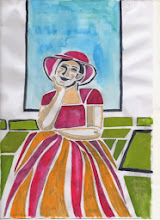 Betsy gave us a still life set-up to look at for 10 mins just to look, not to draw, and then covered it and asked us to draw paint from our memory. My initial painting was a very sketchy watercolour which I greatly enjoyed doing and featured on the large red parasol, a curvy vase, and butterfly and bird motifs from other items.
Betsy gave us a still life set-up to look at for 10 mins just to look, not to draw, and then covered it and asked us to draw paint from our memory. My initial painting was a very sketchy watercolour which I greatly enjoyed doing and featured on the large red parasol, a curvy vase, and butterfly and bird motifs from other items. 
Imagining the flowers on the vase that I invented turning into butterflies and birds I painted them floating onto the parasol.

Then came a still life, using some of the same motifs but thinking ahead to a possible print. Finally, Betsy altered the set-up - gave us another 10 mins. I was very taken with the Buddha' head and the painting grew from that using colours, symbols that I dragged from my memory. I still remember the lovely peaceful feeling when painting this.
On Saturday came "inspirational Sketchbooks" with Sue Brown, organised by the Twenty Twenty Gallery in Much Wenlock. Sue is an artist/printmaker represented by the gallery - www.twenty-twenty.co.uk/Sue-Brown
Sue showed us a technique called gum arabic transfer and after experimenting with the technique, we spent some lovely time sploshing and splashing paint, texture and colour on to an A3 sheet of cartridge paper. Sue then showed us how to cut and fold it into a small sketchbook. I later glued and trimmed it and cut a stencil in the front page to show off colour from inside since I had been very heavy handed with the black ink and my book is quite dark.
I have made another book ready to be trimmed today for an upcoming trip to Edinburgh. In this second attempt I left a lot of white and pale painting space for new images to be added so I can use it as a real sketchbook and record some of my memories of the trip. I have already identified some ideas for using the gum arabic transfer for printmaking projects and also the process of making the books as small personalised gifts.
Yesterday was week 2 with Betsy. She had asked us to bring images/sketches with us to work with. After showing us some of her original sketches - wonderful loose drawings with all the information she needed, and the paintings that were developed from them, we were given 10-15 mins to look at, not sketch, our chosen images. Because I had spent so much time concentrating on the cedars for Project 1 of my OCA course, I chose to feature the Cedars. Now I love trees, can draw them - but always feel disappointed with any paintings I make incorporating trees - so this was going to be a challenge.
Betsy suggested colour sketches first especially if using watercolour. So, after choosing my three colours - I always restrict my paintings to about 3 or 4 colours- this time, magenta, turquoise and cad yellow - perhaps a strange choice but I went with my instinct I completed two sketches. I liked the magenta trees, so went with that colour way. The result was quite interesting until after a break for lunch I over-worked it.
 However I liked the colours, they made some lovely soft browns and greys and with only a short time to spare, Betsy suggested I have another go with a different colour way and perhaps looking at the number of trees and positioning. In the final 10 - 15 mins I produced what I think is the best of the bunch. I broke all the rules - continued working wet into wet, and glazing over wet paint but I quite like it. Doing this has made me realise how valuable the preparatory and development work is. I have always leaped in without enough experimenting and looking before, thinking perhaps that I hadn't got the time to do the sketches, the colour sketches, the working out - but the Cedars are a motif I will come back even though I have finally produced the last piece for the first project.
However I liked the colours, they made some lovely soft browns and greys and with only a short time to spare, Betsy suggested I have another go with a different colour way and perhaps looking at the number of trees and positioning. In the final 10 - 15 mins I produced what I think is the best of the bunch. I broke all the rules - continued working wet into wet, and glazing over wet paint but I quite like it. Doing this has made me realise how valuable the preparatory and development work is. I have always leaped in without enough experimenting and looking before, thinking perhaps that I hadn't got the time to do the sketches, the colour sketches, the working out - but the Cedars are a motif I will come back even though I have finally produced the last piece for the first project.
I am not completely happy with the print - it could have been inked a lot better and more evenly but since it is a dry point on plastic, there is a small finite number of images that can be taken. I will take a final print to eventually send off, concentrating on producing a clean, clear print. However, I feel I am getting closer to producing an image of the Cedars that sums up how I feel about them.




